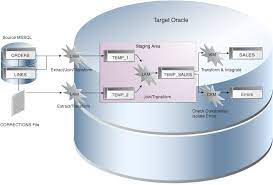In Oracle Data Integrator (ODI), data sources and targets are defined and configured using models and datastores. A model represents a connection to a specific technology or database, and a datastore represents a specific table or file within that model. Here’s how you can define and configure data sources and targets in ODI:
- Define a Model:
- In the Designer Navigator, right-click on the project where you want to create the model and select “New Model.”
- Provide a name and an optional description for the model.
- Select the appropriate technology for your data source or target (e.g., Oracle Database, SQL Server, Flat File, etc.).
- Configure the connection details for the data source or target, such as the server name, port, credentials, and database/schema information.
- Click “Test Connection” to verify the connectivity.
- Click “Finish” to create the model.
- Create a Datastore:
- In the Designer Navigator, expand the project and the model where you want to create the datastore.
- Right-click on the “Datastores” node under the model and select “New Datastore.”
- Specify a name and an optional description for the datastore.
- Define the physical properties of the datastore, such as the table name, schema, columns, data types, and primary keys.
- Configure the logical properties of the datastore, such as the logical schema, logical schema context, and logical schema context code.
- Click “Finish” to create the datastore.
- Configure Datastore Properties:
- In the Designer Navigator, navigate to the datastore that you want to configure.
- Right-click on the datastore and select “Properties.”
- In the properties window, you can configure various settings, such as:
- Physical Properties: These include the database connection details, table properties, and column details.
- Logical Properties: These include the logical schema mapping, logical model, and logical schema context.
- Knowledge Modules: These define the specific code and methodologies used for data integration operations, such as loading, transforming, and extracting data.
- Security: These settings control access and privileges for the datastore.
- Options: These allow you to specify additional options specific to the datastore technology.
- Mapping Data Sources and Targets:
- Once you have defined and configured your datastores, you can use them in mappings to define the flow of data between different data sources and targets.
- In the Designer Navigator, expand the project and navigate to the “Mappings” folder.
- Create a new mapping or open an existing one.
- Drag and drop the source datastore onto the mapping canvas to define the source of the data.
- Drag and drop the target datastore onto the mapping canvas to define the destination for the data.
- Connect the appropriate columns between the source and target datastores to establish the data flow.
By defining and configuring data sources and targets using models and datastores in ODI, you can effectively integrate and manipulate data from various technologies and databases in your data integration processes.
SHARE
